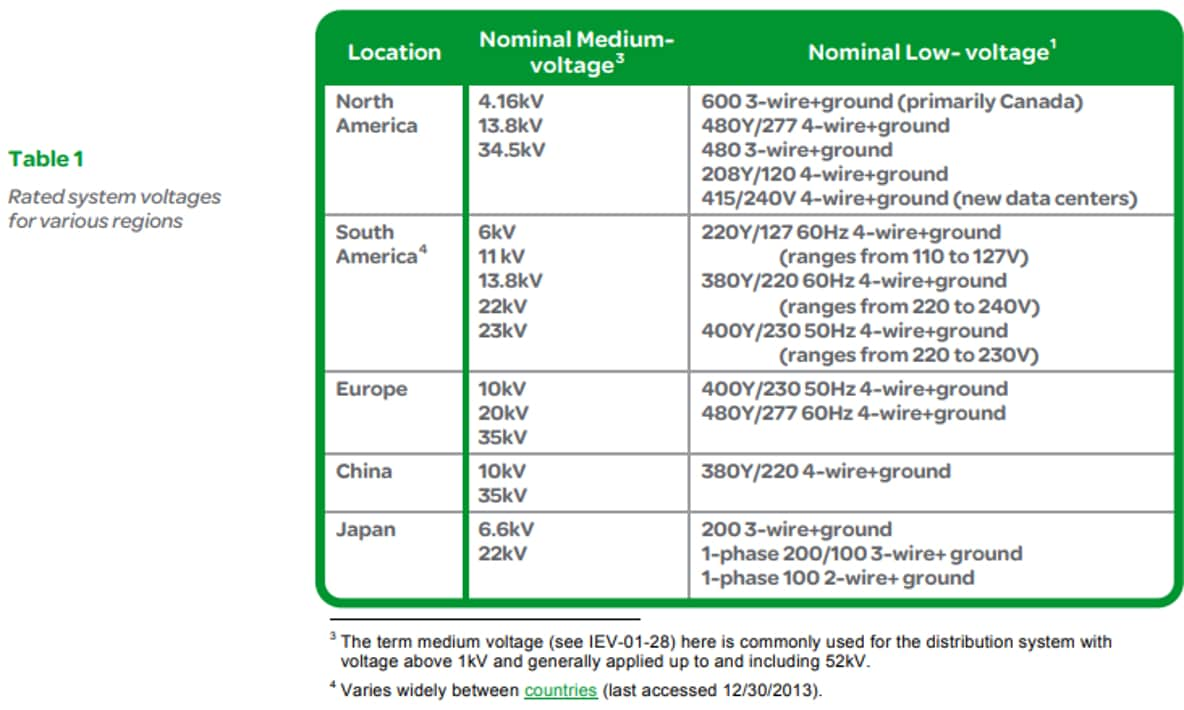-
What does high voltage mean for your data centre?
In Canada, data centre operators have the option of using a voltage of 600V in a three-wire-plus-ground setup to power their IT equipment among other configurations.
-
Do you really need all that power?
Data centres that were incorporated years ago may not align with the original vision as modern equipment has evolved. On the contrary, cloud migrations and hybrid infrastructure could have reduced the power requirements of your data centre.
-
The case for the right-sized UPS
A right-sized UPS setup would be able to support the current needs of the data centre without interruptions while saving costs.
-
How CDW can help with larger data centre builds
While there are smaller UPS devices readily available from various retailers, we go beyond by offering comprehensive power solutions tailored to the unique requirements of larger server rooms and colocations.
-
A single dashboard to monitor power across multiple sites
DCIM enables you to monitor and manage your entire data centre infrastructure from a single dashboard. It collects and analyzes data from various sources, such as power, cooling, security and environmental sensors, as well as IT assets and devices.
January 12, 2024
High Voltage in the Data Centre – What Canadian IT Teams Need to Know
Let’s explore how IT teams can smartly leverage high voltage in data centres to their benefit alongside planning power backups in a way that helps them win back their equipment budgets.

Power is the lifeblood of data centres, but it’s also the biggest expense. For IT teams, it’s about striking the fine balance between providing uninterrupted power supply and optimizing energy efficiency to achieve the best data centre performance while keeping costs in check.
In this pursuit, three factors play a crucial role – how is the power capacity estimated, how is the voltage distribution (or power) managed and how are the uninterruptible power supply (UPS) devices configured.
If the data centre is drawing more power than needed, it’ll turn out too costly, whereas less than optimal power can cause equipment damage. In many cases, organizations often end up stacking more UPS capacity than they would ever use or go for a misfitting UPS type.
In Canada, high voltage of the order of 600 volts or more could prove instrumental in pairing performance with costs. Let’s explore how IT teams can smartly leverage high voltage in data centres to their benefit alongside planning power backups in a way that helps them win back their equipment budgets.
What does high voltage mean for your data centre?
A typical data centre houses a range of IT equipment such as servers, storage devices, coolers and so on, with varying power ratings. Not all IT equipment can operate at higher voltages, and some may require special adapters or connectors to work with high voltage distribution.
Therefore, working with multiple voltages inside a data centre can get confusing at best and risky at worst. Whereas, if the data centre and its equipment adhere to a single voltage standard, it simplifies the power distribution process and minimizes complexity at the same time.
In Canada, data centre operators have the option of using a voltage of 600V in a three-wire-plus-ground setup to power their IT equipment, among other configurations. This voltage is also called the rated electrical supply voltage as it adheres to national standards.

Source: Electrical Distribution Equipment in Data Centre Environments (electrical-engineering-portal.com)
According to the Electrical Safety Authority, high voltage in data centres refers to the use of higher distribution voltages (240V or more) instead of the traditional 120V or 208V in North America. This can improve the power efficiency and reduce the energy consumption of data centres by eliminating some voltage conversion steps and using smaller transformers and wiring. Some of the benefits of high voltage in data centres are:
- Energy savings: High voltage distribution can reduce the power losses and increase the power transfer efficiency.
- Cost reduction: High voltage distribution can lower the capital and operational costs of data centres by using less copper, smaller transformers and fewer power distribution units (PDUs).
- Space optimization: High voltage distribution can free up valuable floor space and cooling capacity by reducing the size and number of power equipment and cables.
In essence, higher voltage promises higher efficiency not just in terms of energy but data centre floor space as well. This opens avenues for optimizations in power distribution design, PDUs and rack configuration, potentially raising the overall effectiveness of a data centre.
Do you really need all that power?
One of the founding questions of a data centre is, “What is the projected power capacity of a data centre over its lifetime?”
This question helps us understand how much power the data centre will require vis-à-vis the equipment it is going to house. Data centres that were incorporated 10 or 20 years ago may not align with the original vision as modern equipment has evolved in terms of power consumption. On the contrary, cloud migrations and the introduction of hybrid infrastructure could have reduced the power requirements of your data centre.
The flip side of it is also true – energy requirements could have increased due to a higher demand in computing resources with new cloud projects being initiated. That’s why it’s vital to audit and evaluate the power consumption of your data centre to verify if the original projections still hold true.
CDW’s data centre power and cooling experts have found that customers might purchase more power capacity than they need for a range of reasons. A general best practice is to not go beyond 80 percent of a UPS system capacity for supporting the total load. But depending on the UPS setup, N+1 or 2(N+1), this calculation can significantly change.
If this happens to be the case, downsizing the capacity for major consumers of power & cooling and UPS can lead to cost savings.
The case for the right-sized UPS
Downsizing capacity always bears the risk of going below the baseline requirements, which is never the goal. The idea is to understand capacity wisely and remove extraneous capacity frugally.
This is also referred to as right-sizing the UPS. A right-sized UPS setup would be able to support the current needs of the data centre without interruptions while saving costs.
CyberPower, one of our partners, offers a high-density UPS that helps in providing the power for your IT devices to run smoothly and more effectively, even in less-than-ideal conditions.
High-density uninterruptible power supply (UPS) systems by CyberPower offer IT managers an innovative solution to the challenge of delivering more power and functionality within limited space. Tailored for high-end components and sensitive electronic devices, these systems ensure uninterrupted power delivery with a zero-transfer time during outages, providing near-perfect power with sine wave output.
These systems, available in capacities from 5K to 10K Watts, maintain all the benefits of standard-density units while occupying up to 50 percent less rack space. This not only optimizes physical space but also grants IT managers flexibility for seamless expansion.
How CDW can help with larger data centre builds
CDW stands out as a reliable partner for customers navigating the intricate landscape of data centre UPS solutions. While there are smaller UPS devices readily available from various retailers, we go beyond by offering comprehensive power solutions tailored to the unique requirements of larger server rooms and colocations.
This distinction is crucial for organizations seeking to optimize their UPS configuration, ensuring the right capacity without unnecessarily inflating costs.
One of the key advantages CDW brings to the table is its collaboration with leading partners in the industry, including notable names such as CyberPower and APC by Schneider Electric.
This partnership enables CDW to provide a diverse array of UPS options, catering to a spectrum of power needs. By leveraging the expertise and product offerings of our partners, we empower customers to design UPS configurations that align precisely with their requirements, striking the delicate balance between optimal capacity and cost-effectiveness.
Whether customers need high-density online UPS systems or smaller-scale solutions, our expansive portfolio ensures access to the right UPS configuration, underlining our commitment to delivering tailored and efficient power solutions for diverse data centre environments.
A single dashboard to monitor power across multiple sites
We’ve talked about the importance of managing data centre power consumption and optimizing it for the best results, but how can administrators monitor power, cooling and other factors without compromising accuracy? One way is to deploy a data centre infrastructure management solution (DCIM).
DCIM enables you to monitor and manage your entire data centre infrastructure from a single dashboard. It collects and analyzes data from various sources, such as power, cooling, security and environmental sensors, as well as IT assets and devices. The software also allows you to control and optimize your power usage, capacity, space and asset utilization.
By using DCIM, you can achieve several benefits for your data centre operations, such as:
- Reducing energy consumption and carbon footprint by improving power efficiency and identifying opportunities for savings
- Enhancing resiliency and availability by detecting and preventing potential risks and failures, and ensuring backup power and cooling systems are ready
- Increasing agility and scalability by planning and simulating changes and impacts, and optimizing resource allocation and utilization
- Improving security and compliance by monitoring and protecting your physical and virtual infrastructure, and generating reports and audits
One of the leading DCIM solutions in the market is EcoStruxure™ IT by Schneider Electric. It’s a comprehensive and vendor-neutral DCIM solution that addresses the challenges of modern data centres, especially in hybrid and distributed IT environments.
EcoStruxure IT offers cloud-based and on-premises software, as well as appliances, cameras and sensors, to provide you with complete visibility and control of your data centre infrastructure.
